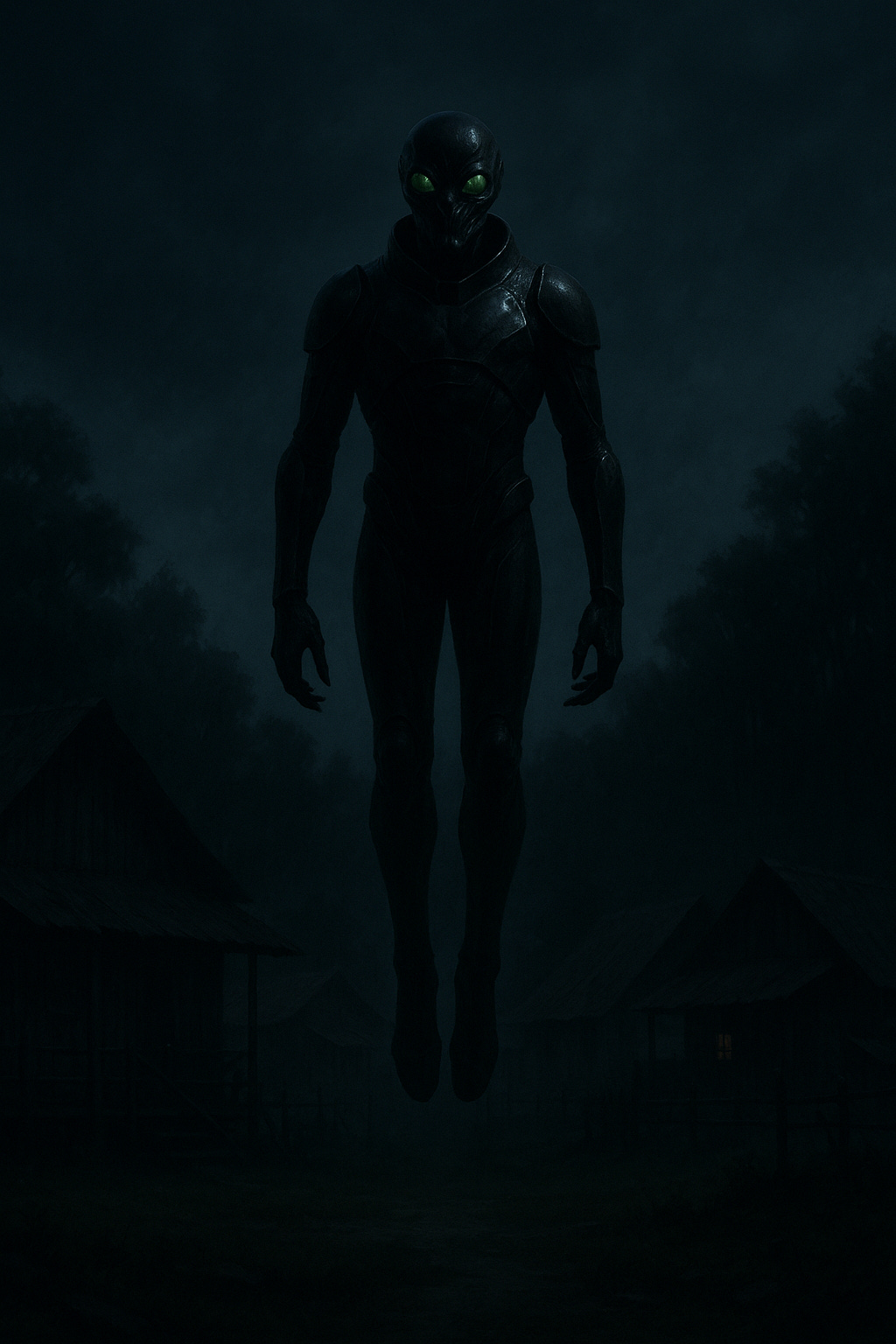The Face Peelers of Peru - Los Pelacaras
Eyewitnesses in the Peruvian Amazon report encounters with towering, faceless beings, linking modern terror to centuries-old Pishtaco legend
Case File: The Face Peelers of Peru
Case No.: 23-LORETO-2023-PE
Classification: High Strangeness, Folklore Crossover with Alleged Alien Activity Location: Alto Nanay District, Loreto Region, Northeastern Peru
Date of Incident: May–August 2023 (with folkloric origins predating colonial era) Filed by: Multiple Eyewitnesses, Community Leaders, Independent Investigators Status: Ongoing, Phenomena Unresolved
Incident Summary
In 2023, the isolated Indigenous communities along the Alto Nanay River in Peru reported a series of unnerving encounters with tall, hooded beings known locally as Los Pelacaras, or "Face Peelers." Witnesses claimed the entities floated above the ground, ignored bullets, and inflicted clean, surgical wounds on victims. Some interpreted the events through the lens of the ancient Pishtaco legend, while others believed they were facing extraterrestrial visitors or human intruders with advanced technology.
Phenomena Overview
Tall, Hooded Apparitions: Witnesses describe figures standing well over average human height, clad in dark, armour-like suits that obscure all features. Some accounts report them hovering above the ground or river surface.
Mutilations: Both animals and at least one human victim suffered clean, bloodless incisions. The precision of these cuts mirrors those described in traditional Pishtaco legends.
Resistance to Weapons: Multiple testimonies claim that close-range gunfire had no visible effect, with the figures retreating unharmed into the darkness.
Nocturnal Activity: All encounters occurred after nightfall, often in remote paths, riverbanks, or fields bordering the villages.
Psychological Impact: Fear has reshaped community life. Curfews are in place, markets close early, and many families sleep together in communal halls for safety.
Investigation Overview
Initial Reports: First accounts were broadcast on local radio, spreading quickly between villages. By July 2023, the story had reached national and international media outlets.
Community Defence: Villagers organised armed night patrols, equipped with shotguns, rifles, and machetes, to guard the perimeters.
Independent Investigation: Researcher and explorer Timothy Alberino travelled to the Alto Nanay, interviewing multiple eyewitnesses and documenting their accounts.
Official Response: Authorities attributed the incidents to illegal miners equipped with advanced gear such as jetpacks, a claim met with scepticism from locals.
Folklore Connection: The beings are strongly associated with Pishtaco legends. These describe outsiders who extract fat or flesh, although modern accounts add the elements of strange technology and coordinated movement.
Documented Phenomena
Appearance: Tall, hooded silhouettes with an armour-like exterior, lacking visible human features.
Movement: Able to float or hover, moving silently and vanishing instantly when approached.
Abilities: Suspected advanced cloaking or propulsion systems, possibly accounting for the silent hovering and sudden disappearances.
Interaction: At least one recorded instance of a figure making physical contact, causing injury to a human witness.
Environmental Clues: A low, mechanical humming sound is frequently reported moments before an encounter.
Press Coverage and Public Reaction
Media Framing: Headlines often sensationalised the encounters, portraying them as alien attacks or paranormal assaults.
Social Media Influence: WhatsApp groups, TikTok, and Instagram amplified fear through alleged video footage and real-time alerts.
Debate: Scholars and commentators have discussed whether the sightings represent a continuation of ancient folklore or an entirely modern threat using advanced technology.
The Story
The Alto Nanay is not an easy place to reach. Tucked deep within the Peruvian Amazon, its villages cling to the bends of the river like beads on a winding thread. The forest here is not just scenery, it is a living wall of heat, shadow, and noise. The trees close in so tightly that the river becomes the only road. In these communities, survival depends on knowing the moods of the water, the patterns of the fish, and the timing of the seasons.
In May 2023, that rhythm, steady and predictable for generations, was broken.
It began with a lone hunter making his way back to his village one humid night. The moon hung low, barely filtering through the thick canopy. On the edge of the treeline, he noticed something strange: a tall figure, impossibly still, almost blending into the dark. It was clothed in black from head to toe, absorbing what little light touched it. Its proportions were subtly wrong, longer, taller, and thinner than any man he knew. When the hunter approached, calling out a cautious greeting, the figure simply moved away. It did not walk so much as drift, making no sound. By the time he reached the spot, there was nothing. No footprints, no rustle of leaves, not even a snapped twig.
He told himself it was a trick of the light, but the next day, he shared the story. And in the days that followed, others began to report the same thing.
Farmers in the cassava fields began spotting unmoving silhouettes at a distance. Fishermen returning from the river at dusk reported shapes pacing them silently from the bank, gliding alongside their boats without breaking stride. Families making the journey home after sunset began to speak of a faint mechanical hum, low and steady, that came just seconds before a figure would emerge in the gloom. The details were unnervingly consistent. Every report spoke of height, absolute silence, and an unmistakable sensation: the feeling of being observed.
The unease became fear in early June. Two teenage sisters were walking a narrow forest path when one of the figures appeared ahead of them, blocking the way. The elder stepped forward, trying to shield her younger sibling, and the thing reached out. She recoiled, feeling a sharp, burning sting along her jaw. Back at home, the family inspected the wound. It was a long, narrow incision, bloodless and strangely clean, as if cut with a surgeon’s scalpel. The elders recognised it instantly. It was just like the wounds described in the stories of the Pishtaco, a legendary figure in Andean folklore said to kill and extract human fat.
The connection was made. The black-clad figures were christened Los Pelacaras, the Face Peelers.
By mid-June, the fear was so intense that the villages took up arms. Every night, armed patrols guarded the perimeter. Men with shotguns, rifles, and machetes watched every approach, their torches scanning the dark edges of the forest. In one chilling encounter, a patrol spotted a figure standing just beyond the reach of their lights. They opened fire from close range. The blasts echoed in the still air, but the figure did not fall. It did not even flinch. Slowly, it turned and slipped back into the shadows, unharmed.
By late June, it was no longer just one village under siege. Across the Alto Nanay, communities were reporting simultaneous encounters. In some places, witnesses saw the figures hovering above the river, their lower halves obscured by drifting mist. In others, three moved in formation through a cassava field, gliding effortlessly over the uneven ground. That same week, livestock began turning up dead. Dogs, pigs, and chickens were found with precise incisions and no trace of blood, just as in the old Pishtaco stories.
July brought panic. Radios carried urgent warnings between communities. WhatsApp groups became lifelines for real-time alerts. Short, shaky videos began appearing online: distant lights above the canopy, or vague dark forms moving unnaturally between trees. The media took notice. Local news stations dispatched reporters. TikTok and Instagram filled with theories, some claiming it was evidence of aliens, others pointing to shadowy paramilitary experiments.
Authorities offered their own explanation. Illegal gold miners using advanced equipment, perhaps even jetpacks, to intimidate and drive villagers away from certain areas. But the people of the Alto Nanay rejected this outright. How could miners appear in multiple villages miles apart within minutes? How could they float in silence for long periods? And why had point-blank gunfire failed to bring one down?
For the elders, the parallels to ancient fears were undeniable. Pishtacos were said to come from outside, to take life and resources without permission. But these new beings seemed different, stranger. They had no visible faces. They moved with precision. They worked together. And they possessed technology unlike anything the villagers had seen.
Markets began closing early. Children slept together in communal halls for safety. Armed guards still watch the edges of the villages every night. Now, when the evening fires are lit, the conversations drift between past and present. Folklore and fresh memory merge into a single story. The legend of Los Pelacaras has entered the living history of the Alto Nanay, at once a chilling new reality and the latest chapter in a centuries-old fear.
And in the darkness beyond the fires, the forest waits, holding secrets it will not easily give up.





This is amazingly creepy! I had not heard about the "face peelers," although I've researched the Pishtaco legends in the interest of an urban fantasy-type story that may take place somewhere between Cusco and Machu Picchu. The parallels are definitely disconcerting - the outsiders with their technology and their greed, extracting everything they can from the local population, even their fat. To have similar tales reemerge with modern, almost alien technology... very disturbing!
I think the chief suspect, as is often the case, should be the good old CIA... Or whichever deep state group is responsible for the 'it's aliens' psyop (possible preparation for operation Bluebeam, perhaps? https://open.substack.com/pub/inadifferentplace/p/event-day-plus-fourteen-and-a-half?r=2s9hod&utm_campaign=post&utm_medium=web&showWelcomeOnShare=true)